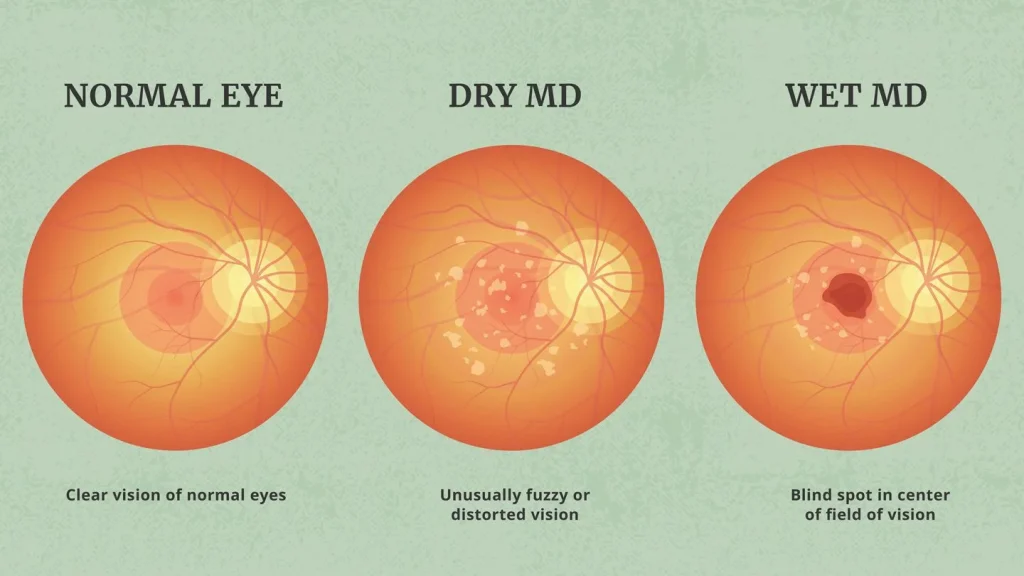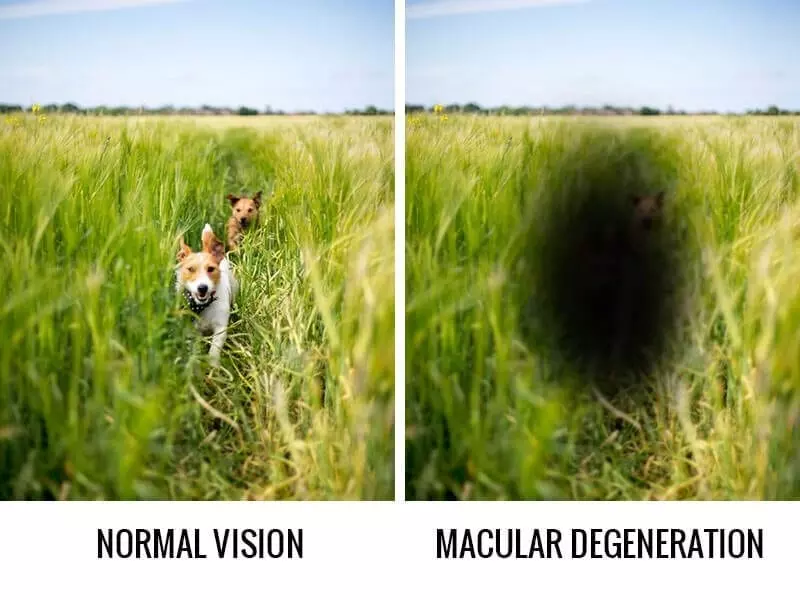Age-Related Macular Degeneration: Definition, types, symptoms, causes, and treatments
As we journey through life, our eyes serve as the windows to the world, allowing us to experience its beauty and wonder. However, as we age, certain eye conditions can cast shadows on this visual journey. Age-Related Macular Degeneration (AMD) is one such condition that demands our attention.
In this comprehensive blog post, we will delve into the intricacies of AMD, unraveling its mysteries and exploring the various aspects related to its occurrence, symptoms, treatment options, and preventive measures. Our aim is to equip you with the knowledge and understanding needed to protect and preserve your vision even as time advances.
What is Age-Related Macular Degeneration (AMD)?
Age-Related Macular Degeneration is a progressive eye condition that affects the macula, a small but crucial part of the retina responsible for sharp central vision. As the name suggests, AMD typically affects individuals aged 50 and above. The condition slowly blurs the central vision, making it challenging to see fine details and perform daily tasks like reading, driving, and recognizing faces.
Age-Related Macular Degeneration ICD-10 Code
The International Classification of Diseases, 10th Revision (ICD-10), provides a specific code for AMD: H35.3. This code helps healthcare professionals accurately diagnose and classify the condition for appropriate treatment and insurance purposes.

Types of Age-Related Macular Degeneration
Age-Related Macular Degeneration (AMD) can be categorized into two main types:
Nonexudative Age-Related Macular Degeneration (Dry Age-Related Macular Degeneration)
Dry AMD, also known as non-neovascular or atrophic AMD, is the more common and less severe form of the condition. It occurs when the light-sensitive cells in the macula, the central part of the retina responsible for sharp central vision, gradually break down and degrade. This degeneration leads to the formation of small yellow deposits called drusen beneath the retina.
At the early stages of Dry AMD, drusen formation may not cause noticeable vision changes. However, as the disease progresses, the accumulation of drusen can lead to thinning and atrophy of the retinal tissues, resulting in blurred central vision and difficulties with detailed tasks like reading and recognizing faces.
In some cases, Dry AMD can progress to an advanced stage known as geographic atrophy, where there is a significant loss of retinal tissue in the macular area, leading to severe and irreversible central vision impairment.
Exudative Age-Related Macular Degeneration (Wet Age-Related Macular Degeneration)
Wet AMD, also called neovascular AMD, is the less common but more severe and aggressive form of the condition. It occurs when abnormal blood vessels (choroidal neovascularization) grow beneath the retina. These new blood vessels are fragile and prone to leakage of blood and fluid into the macula, causing swelling and damage to the retinal cells.
The leakage and bleeding associated with Wet AMD lead to rapid and significant vision loss, often affecting the central vision. Straight lines may appear wavy or distorted, and central vision may become blurred or darkened. If not promptly treated, Wet AMD can cause severe and permanent vision loss.
It’s important to note that Dry AMD and Wet AMD are not mutually exclusive, and an individual with Dry AMD may progress to develop Wet AMD. Regular eye examinations are crucial for early detection and appropriate management of both types of AMD.
Age-Related Macular Degeneration Symptoms
Age-Related Macular Degeneration (AMD) is a chronic eye condition that primarily affects central vision. Remember, AMD symptoms may vary depending on the type and stage of the disease. The following is a summary of AMD symptoms:
- Blurred or Diminished Central Vision: Gradual or sudden loss of clear central vision, making it difficult to see fine details and perform tasks like reading and recognizing faces.
- Distorted Vision: Straight lines may appear wavy, crooked, or distorted (metamorphopsia).
- Dark or Empty Spots: Blind spots or dark areas may develop in the center of the visual field.
- Reduced Color Perception: Colors may appear muted or washed out.
- Difficulty with Low Light Conditions: Struggling to see in dim lighting or low-contrast environments.
- Slow Adaptation to Lighting Changes: Longer time is needed to adjust between bright and dim lighting.
- Visual Hallucinations (Charles Bonnet Syndrome): Some individuals with advanced AMD may experience visual hallucinations, seeing patterns or shapes that are not there.
Utilize the Amsler grid for monitoring your eyesight
You should use an Amsler grid every day to monitor your vision. Keep the Amsler grid in a place where you see it every day. Many people keep an Amsler grid on their refrigerator door or on their bathroom mirror.
In good light, look at the grid from about 12–15 inches away. Be sure to wear your reading glasses if you normally use them. Cover one eye. Look directly at the dot in the center of the grid with your uncovered eye. Notice if any of the lines look bent or wavy. See if any part of the grid looks blurry, dim, or out of shape. Now cover your other eye and test your vision this same way again.
Call your ophthalmologist right away if you notice that any lines or parts of the grid look wavy, blurry, or dim.

Age-Related Macular Degeneration Causes
The exact cause of AMD is not fully understood, but it is believed to be a combination of genetic and environmental factors. Some common risk factors include:
- Age: The risk of AMD increases significantly after the age of 50.
- Family History: A family history of AMD increases the likelihood of developing the condition.
- Smoking: Smoking is a significant modifiable risk factor for AMD.
- Cardiovascular Disease: Conditions like hypertension and high cholesterol may increase the risk of AMD.
- Race and Ethnicity: AMD is more common among Caucasians.

Age-Related Macular Degeneration Treatment
Age-Related Macular Degeneration (AMD) is a chronic eye condition for which there is currently no cure. However, several treatment options are available to help slow down the progression of AMD and manage its effects, especially for the wet form of the disease. The choice of treatment depends on the type and stage of AMD and is best determined by an ophthalmologist or retina specialist. Some common treatment options for AMD include:
Anti-VEGF Injections
For Wet AMD, the most effective and widely used treatment is anti-vascular endothelial growth factor (anti-VEGF) injections. VEGF is a protein that promotes the growth of abnormal blood vessels beneath the retina in Wet AMD. Anti-VEGF drugs block this protein’s action, helping to halt the growth of new blood vessels and reduce leakage of fluid and blood. These injections are typically given into the vitreous, the gel-like substance in the eye, at regular intervals, and multiple treatments may be needed over time.
Photodynamic Therapy (PDT)
In some cases of Wet AMD, photodynamic therapy may be used. This treatment involves injecting a light-activated drug into the bloodstream. The drug is then activated by shining a special laser light into the eye, causing it to selectively target and close the abnormal blood vessels.
Laser Photocoagulation
Laser therapy can be used to treat specific types of abnormal blood vessels in Wet AMD. The laser is directed at these vessels to seal and prevent leakage, reducing damage to the macula.
Nutritional Supplements
For some individuals with intermediate to advanced Dry AMD, certain high-dose antioxidant vitamins and minerals may be recommended. The Age-Related Eye Disease Study (AREDS) and AREDS2 trials have shown that specific combinations of vitamins and minerals, including vitamins C and E, zinc, copper, and beta-carotene (or lutein and zeaxanthin), can reduce the risk of AMD progression.
Low Vision Aids
For individuals with advanced AMD and significant vision loss, low vision aids such as magnifiers, telescopic lenses, and other visual aids can help enhance remaining vision and improve quality of life.
It’s essential to note that while these treatments can be effective in slowing down AMD’s progression and preserving vision, they may not fully restore vision that has already been
How to Prevent Age-Related Macular Degeneration
While some risk factors like age and genetics are beyond our control, certain lifestyle changes can help reduce the risk or slow the progression of AMD:
- Quit Smoking: If you smoke, consider quitting to reduce your risk of AMD and other eye conditions.
- Eat a Healthy Diet: Include foods rich in antioxidants, vitamins A, C, and E, zinc, and omega-3 fatty acids in your diet. These nutrients may support eye health.
- Regular Exercise: Staying physically active can help maintain overall health, including eye health.
- Protect Your Eyes from UV Rays: Wear sunglasses with UV protection when outdoors to shield your eyes from harmful UV rays.
- Routine Eye Exams: Regular comprehensive eye exams are essential, especially for those over 50, as early detection and treatment can make a significant difference.
Age-Related Macular Degeneration is a serious eye condition that can impact your quality of life. Understanding its types, symptoms, treatment options, causes, and preventive measures empowers you to take proactive steps to protect your eyesight. At European Eye Center, our dedicated team of eye care professionals is here to provide personalized care and guidance to help you maintain clear and healthy vision throughout your life. Book your comprehensive eye exam today, and let us partner with you in the fight against AMD.
